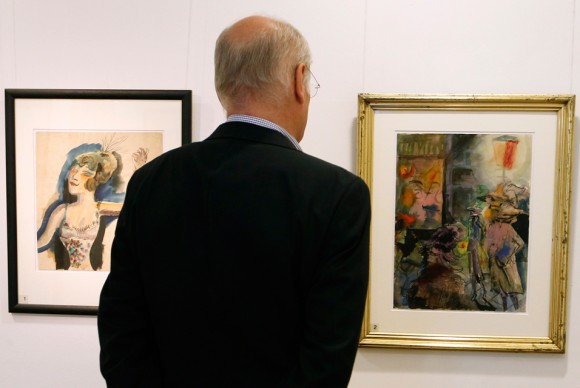Galerie Remmert und Barth finds art by Nazi-branded “degenerate” Expressionist Otto Dix
BERLIN (REUTERS).- A gallery has discovered four paintings by Otto Dix, the German expressionist whose art chronicled the horrors of World War One, the depravity of the Weimar Republic and was labeled “degenerate” by Adolf Hitler.
Famous for works critical of the darker side of German society in the 1920s, Dix’s paintings were discovered among the belongings of his wife, gallery owner Herbert Remmert told Reuters Wednesday.
The paintings were found in a portfolio untouched for decades on an estate in Bavaria owned by the ancestors of a Duesseldorf doctor and art collector who remained close to Dix even after his wife left him for the artist.
The three watercolors and one painting-study date from the first two years Dix spent in Duesseldorf from 1922-1925.

- Gallery owner Herbert Remmert looks at recently discovered paintings of German artist Otto Dix during an exhibition in his gallery in Duesseldorf, August 31, 2011. Four paintings by expressionist artist Otto Dix, famous for works critical of the darker sides of German society in the 1920s, were discovered among the belongings of his wife, a gallery owner said on Wednesday. The three watercolours and one painting-study were found in a portfolio untouched for decades in an estate in Bavaria owned by the ancestors of Duesseldorf art collectors who were close to Dix. REUTERS/Ina Fassbender.
“This period represents some of the most important years for Otto Dix as an artist,” Remmert said. “It was during this time that Dix really developed his themes. Even his technical skills developed — his watercolor paintings matured and became more refined.”
Dix was one of the leading artists of his era. When World War One broke out in 1914, he volunteered for the army and served on various frontlines, including the Somme, until he was wounded and discharged from service in 1918.
He initially produced gruesome drawings and paintings portraying mangled soldiers in battle. As time went on, Dix also became increasingly critical of postwar German society during a period in which soaring inflation meant financial ruin for most.
In his works from the 1920s, he captured the depravity of indulgence and destitution that marked the Weimar Republic.
His famous 1928 triptych “Metropolis,” contrasts a crippled veteran surrounded by prostitutes in a Berlin red-light district while rich patrons dance in an American-style jazz club.
When the Nazis took power in 1933, Hitler branded Dix a degenerate and had many of his most important works burned.
Gallery owners Peter Barth and Remmert tracked the works down at the Bavarian estate by accident. They were searching for other art on the estate owned by the daughter and granddaughter of the Duesseldorf collectors Hans and Martha Koch.
Dix became entangled in the lives of the Kochs in Duesseldorf. Hans Koch was a doctor and a leading art collector. Koch’s wife, Martha, fell in love with Dix and their affair led her to divorce Koch and leave her two children. Dix later married Martha in 1923.
Hans Koch and Dix nevertheless remained close.
The Remmert gallery in Duesseldorf has collaborated with the family for more than 20 years and has discovered other treasures on the estate. But this is the first Dix discovery.
Last year, Remmert and Barth found a watercolor by Dix contemporary George Grosz titled “Germany, a Winter’s Fairytale.”
Dix was famous both for his portraits and his dour depictions of Weimar society. The new discoveries will likely add to his legacy.
Among the works found, two watercolors are titled “Naechtens” and “Soubrette” and the third is a large-scale work titled “Strich III,” depicting a street-scene with prostitutes.
The fourth work is a study for the portrait of art-dealer Alfred Flechtheim. The famous portrait painted in 1926 currently hangs in the New National gallery in Berlin.
The newly found works are valued at about 200,000 euros ($287,960) each, according to Remmert.
The Remmert gallery plans to show the discovered paintings among other Dix works in an exhibition later this year.
Remmert suspects the Koch estate holds additional undiscovered works. The estate also houses several children’s books painted by Dix but the family wants to hold off on releasing them.
“For that, we will have to be a bit more patient,” Remmert said.
Related posts:
- Exhibition of German Expressionist Max Pechstein’s Work on View at the Ahlen Art Museum
- Hamburger Kunsthalle Opens First Major Philipp Otto Runge Retrospective in Thirty Years
- German Museum Finds Rare Ludwig Kirchner in Cellar
- Timothy Taylor Presents Ambitious Late Paintings by Abstract Expressionist Hans Hartung
- Exceptional Group of Works by Uta Barth at Tanya Bonakdar Gallery
